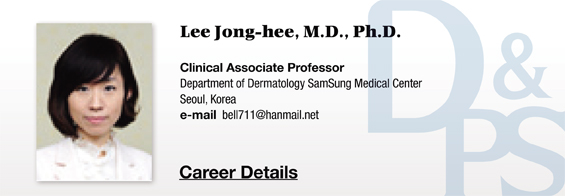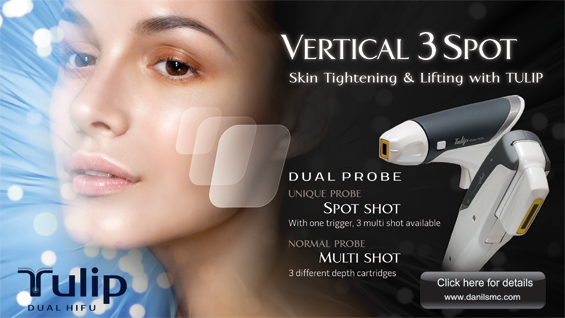Since mid-2000s, 1,550nm Erbium-doped fiber fractional laser(Fraxel) has been used for skin aging, scar and even melasma with a sucess1-6. The therapeutic principle of this device is defined as “ fractional photothermolysis”, which creates microscopic epidermal and dermal necrotic zone in the dermis. These thermally denatured columns are surrounded by normal epidermis, which enables rapid healing after treatment and patients can return to their daily life with shorter down time compared with conventional whole epidermal ablative treatment modalities.
[Advertisement] Tulip(Skin Tightening & Lifting) – Manufacturer: DANIL SMC(www.danilsmc.com)
In addition to the early Fraxel (Nonablative Laser), the idea of fractionated photothermolysis has been also introduced to ablative lasers, such as Erbium or CO2 laser, for clinical use.
When applying laser resurfacing, care should be taken generally for the risk of postinflammatory hyperpigmentation, hypertrophic scar, infection and herpes viral reactivation. Fractional photothermolysis is known to induce less postoperative side effects compared to laser resurfacing.
Lately, laser resurfacing is used less frequently and rather switched to fractional laser in most patients requiring resurfacing. Doctors often care about the risk of periprocedural pain, postoperative erythema, edema and postinflammatory hyperpigmentation and provides detailed description about them to their patients; however, not many of them worry less about the risk of herpes viral reactivation. By analyzing 46 cases who procedure with CO2 Fractional laser, Naouri et al.7 reported that 21.7% experienced side effects. The most frequent one among them was facial herpes simplex (10.6%). Even patients who received 500mg of prophylactic valacyclovir also reported the incidence of herpes simplex.
Other than that, 8.7% of patients reported inflammatory response and 2.2% reported the development of acne. The authors concluded that it would be beneficial to administer 500mg of valacyclovir twice a day before the procedure in every patient. Graber et al.8 analyzed the incidence of side effects among 961 cases treated with 1,550nm Erbium-doped Fractionated Laser (Fraxel). Among the 961 cases, only 73 cases reported side effects (7.6%); the most common was acneiform eruption (1.87%), followed by herpes simplex (1.77%). All side effects were evenly distributed across every age, skin type, body area, laser parameter and skin condition, although postinflammatory hyperpigmentation was more common among patients with dark skin.
I also have encountered the development of herpes simplex not uncommonly after Fraxel procedure. I always investigate the history of herpes simplex before performing a procedure with Fraxel or CO2 Fractional Laser, and make sure to administer 7-day prophylactic antiviral agent in patients with previous history of cold sore. However, even with prophylactic antiviral therapy before the treatment of scar from acne or chicken pox (herpes simplex seems more frequent after compact MTZ(microscopic treatment zones) with higher fluence) and intravenous injection of acyclovir on the day of procedure, patients with recurrent herpes simplex still experienced the recurrence (Fig. 1). Early treatment of herpes simplex may not have a remarkable impact on the postprocedural scar or the prognosis of the procedure, but when left untreated, it may leave unpleasant looking pigmentation or scar around the lips. Since patient’s satisfaction may vary depending on whether or not the patient had been told the risk in advance, patients should be fully informed of such risks before the procedure.

Fig 1. A female patient in her 60s visited for the treatment of scar from chicken pox in childhood. Herpes simplex developed the day after the procedure, for which 250mg of famciclovir was administered three times a day. The picture shows the prognosis 7 days after the therapy, with facial edema and erythema subsided but the lesion of herpes simplex is still present.
Preventive measures before laser resurfacing, regardless of the history of herpes simplex, include 400mg of acyclovir 3 times a day, 500mg of valacyclovir twice a day, or 250mg of famcyclovir twice a day, from 2 days before the procedure until at least 10 days after the procedure.
Patients showing herpes simplex after fractional laser are all those with the history of herpes simplex; therefore, it would be sufficient to provide the preventive measure only in patients with the history. Prophylactive regimen 5-7 days before the procedure would be clinically sufficient.
References
1. Bass LS. Rejuvenation of the aging face using Fraxel laser treatment. Aesthet Surg J 2005;25:307~309.
2. Wanner M, Tanzi EL, Alster TS. Fractional photothermolysis: treatment of facial and nonfacial
cutaneous photodamage with a 1,550-nm erbium doped fiber laser. Derm Surg 2007;33:23~28
3. Collawn SS. Fraxel skin resurfacing. Ann Plast Surg 2007;58:237~240.
4. Chiu RJ, Kridel RW. Fractionated photothermolysis: the Fraxel 1550nm glass fiber laser treatment. Facial Plast Surg Clin North Am 2007;15:229~237.
5. Lee HS, Lee JH, Ahn GY et al. Fractional photothermolysis for the treatment of acne scars; a report of 27 Korean patients. J Dermatol Treat 2008;19:45~49.
6. Katz TM, Glaich AS, Goldberg LH et al. Treatment of melasma using fractional photothermolysis: a report of eight cases with long term follow up. Derm Surg 2010;36:1273~1280.
7. Naouri M, Delage M, Khallouf R et al. CO2 fractional resurfacing:side effects and immdediate complications. Ann Dermatol Venereol 2011;138:7~10.
8. Graber EM, Tanzi EL, Alster TS. Side effects and complications of fractional laser photothermolysis:experiences with 961 treatments. Derm Surg 2008;34:301~305.
9. Mahmoud BH, Srivastava D, Janiga JJ et al. Safety and efficacy of erbium-doped yttrium aluminum
garnet fractionated laser for treatment of acne scars in type IV to VI skin. Derm Surg 2010;36:602~609.
- To be continued -
n
▶ Previous Artlcle : #2. Precautions for New Vascular Lasers
▶ Next Article : #4. Possible Side Effects of Photoepilation





















